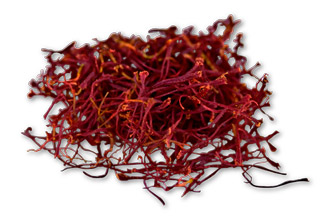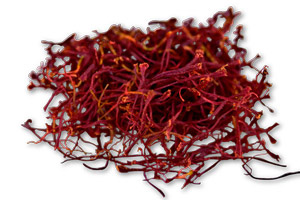HOW TO CHOOSE THE BEST SAFFRON
Sorting through your saffron options can be confusing. We weigh the pros and cons and offer some tips.
SAFFRON THREADS VS. SAFFRON POWDER
Saffron threads are easy to count out, easier to judge for quality at a glance, and can look very pretty in the finished dish, so most pro chefs prefer them. Saffron powder, on the other hand, doesn't need to be pre-steeped and takes up less space, making it popular with some home chefs
HOW TO JUDGE SAFFRON QUALITY
The most highly regarded saffron in the world is Persian. Iran produces upwards of 90% of the world’s saffron but because of sanctions it is difficult to obtain. Saffron is also grown in Afghanistan and Spain. Which saffron you should buy is largely a matter of personal preference, assuming you’re deciding between saffron of equal quality.
The first rule of choosing saffron is: the redder the saffron the better the quality. When most people think of what saffron looks like, they visualize a tiny glass or plastic container, with a few red & yellow threads in it. The funny thing is that isn’t what pure saffron looks like.
Those yellow bits are called “styles”… and while they come from the same crocus flower they aren’t saffron at all. The part of saffron you want is the dark orange/red stigma.
Because of saffron’s extremely high value per gram, and the added effort needed to remove it, many (if not most) saffron producers do not remove the long yellow style that trails below the red stigma. The style does not add any culinary value to the saffron but can inflate its weight by as much as 50%.

PRETTY GOOD SAFFRON
As a rule, what you want to look for is saffron that is as red as possible. In fact, saffron brokers, hardcore fanatics & chefs who cook with it a lot insist on hard “color potency” numbers (from a spectrophotometer, no less), to judge how good the saffron they’re being offered is.
As a home chef, do you really need to memorize quantified color ranges? No. Just look for the yellow and avoid buying if there’s a lot. While it is almost certain that even the best saffron will include at least a few yellow styles, you don’t want to see very many. See the difference from the photo above?

GREAT SAFFRON
The above photo shows “short-sargol” grade Persian saffron. None of the style is included, which is why it is so red. We’ve noticed that even the best saffron can include one or two threads with the style on in the package (and have heard that they’re intentionally included as “proof” that the saffron hasn’t been dyed by unscrupulous producers). That darker color really pays off when it comes time to cook with your saffron. Higher grade saffron is more potent, so you don’t have to use as much of it in your dishes.
Note: If you're buying Spanish saffron threads, their equivalent grade is "Superior/Selected"
HOW TO CHOOSE SAFFRON POWDER
Though as a rule we prefer whole spices to pre-ground because you often get better flavor, there are some good saffron powders on the market. Unfortunately, it’s harder to tell the quality of powdered saffron just by looking at it because the yellow styles are ground in. To determine its quality without trying it, you either need to see the saffron threads it’s made from or hard color potency numbers. Persian saffron powder that is made from sargol-grade saffron threads will test at the same (high) level of potency as the original threads.
Once you've chosen your saffron, try one of these recipes:
Quick Lingcod & Mussel Bouillabaisse with Piquillo Rouille
Citrus & Saffron Braised Rabbit Legs with Potatoes
Fried Quail Breasts with Saffron Ajo Sauce & Grape Gremolata



Comments 2
fantastic excellent
Well explanation. Thank you.